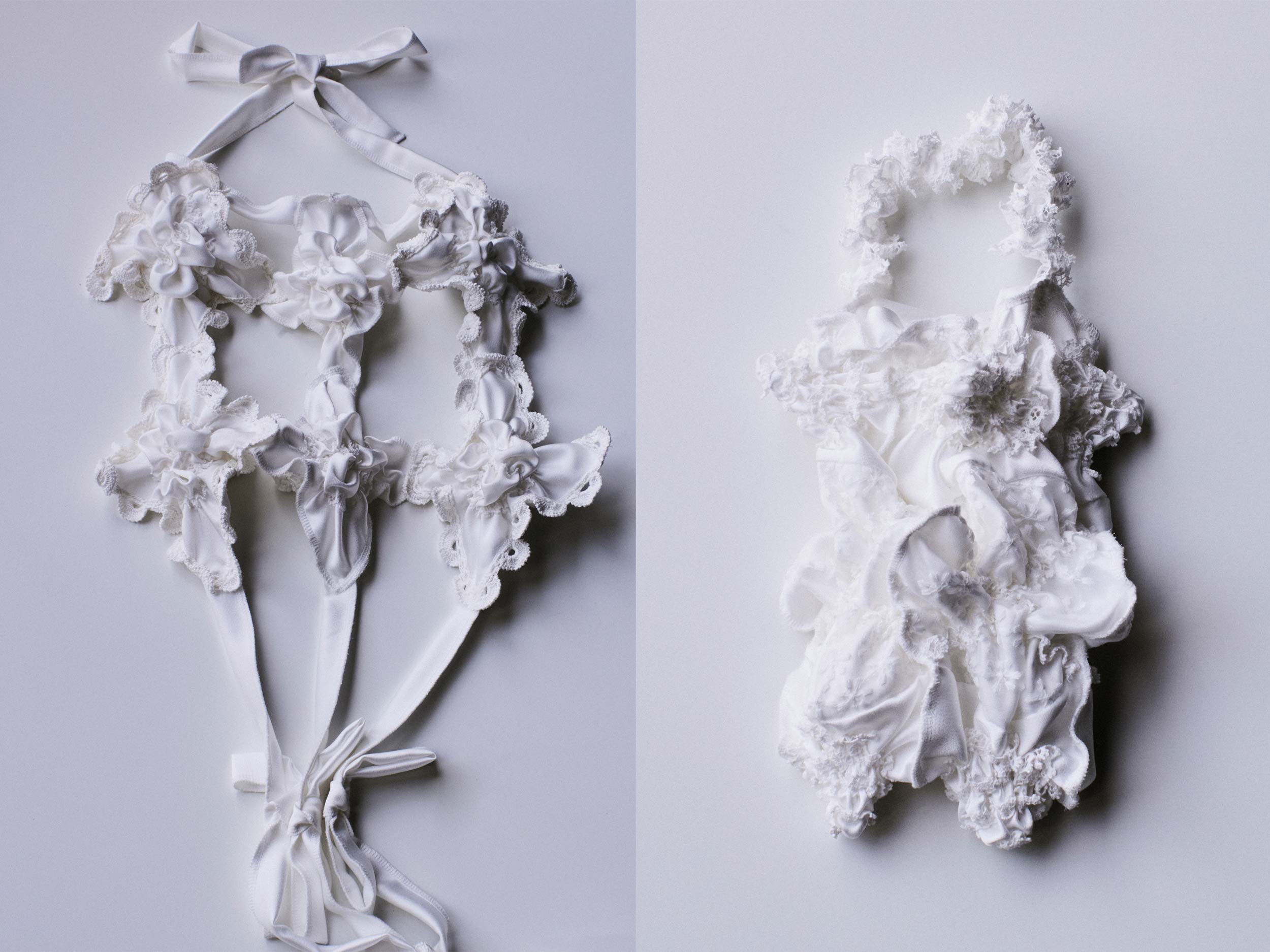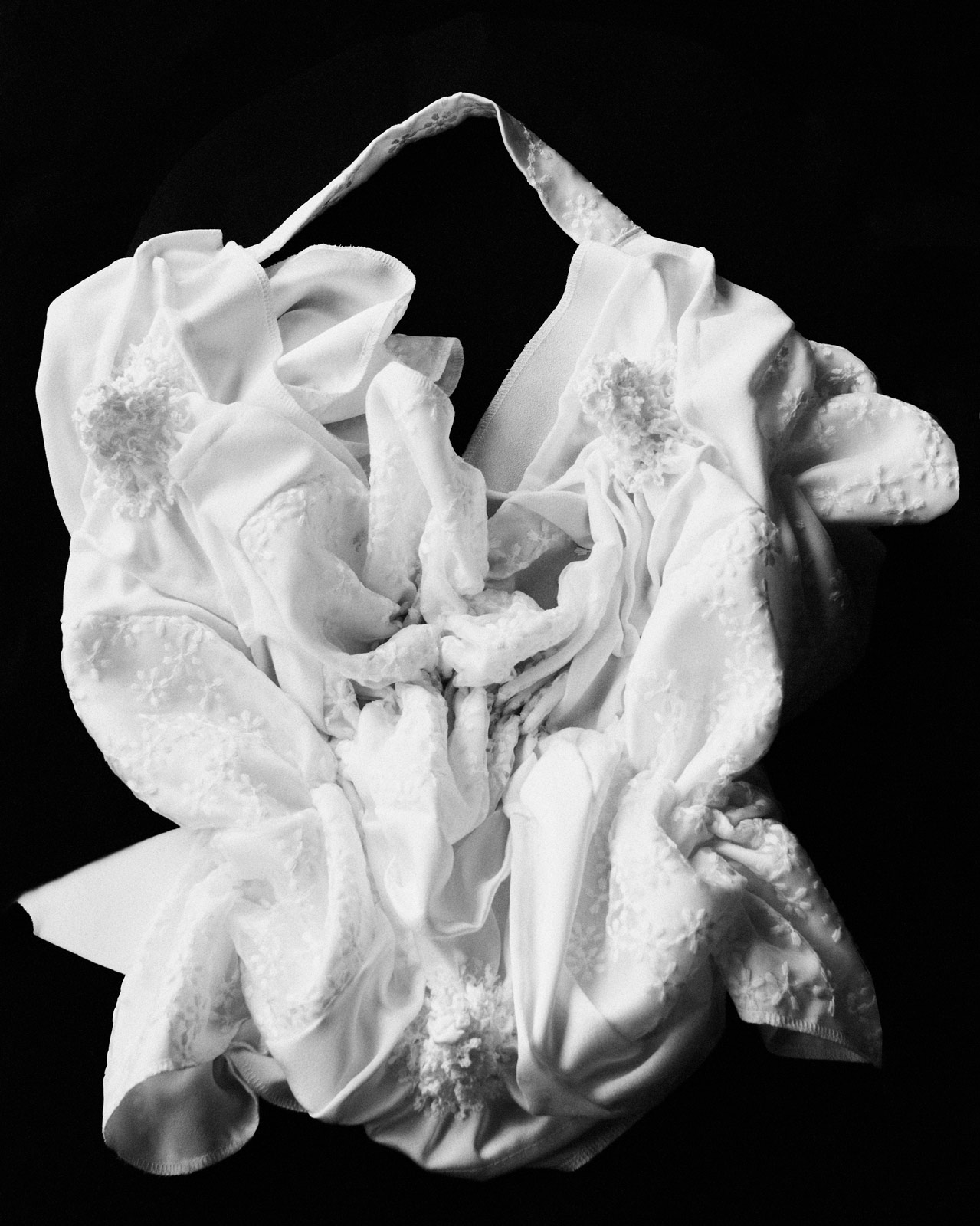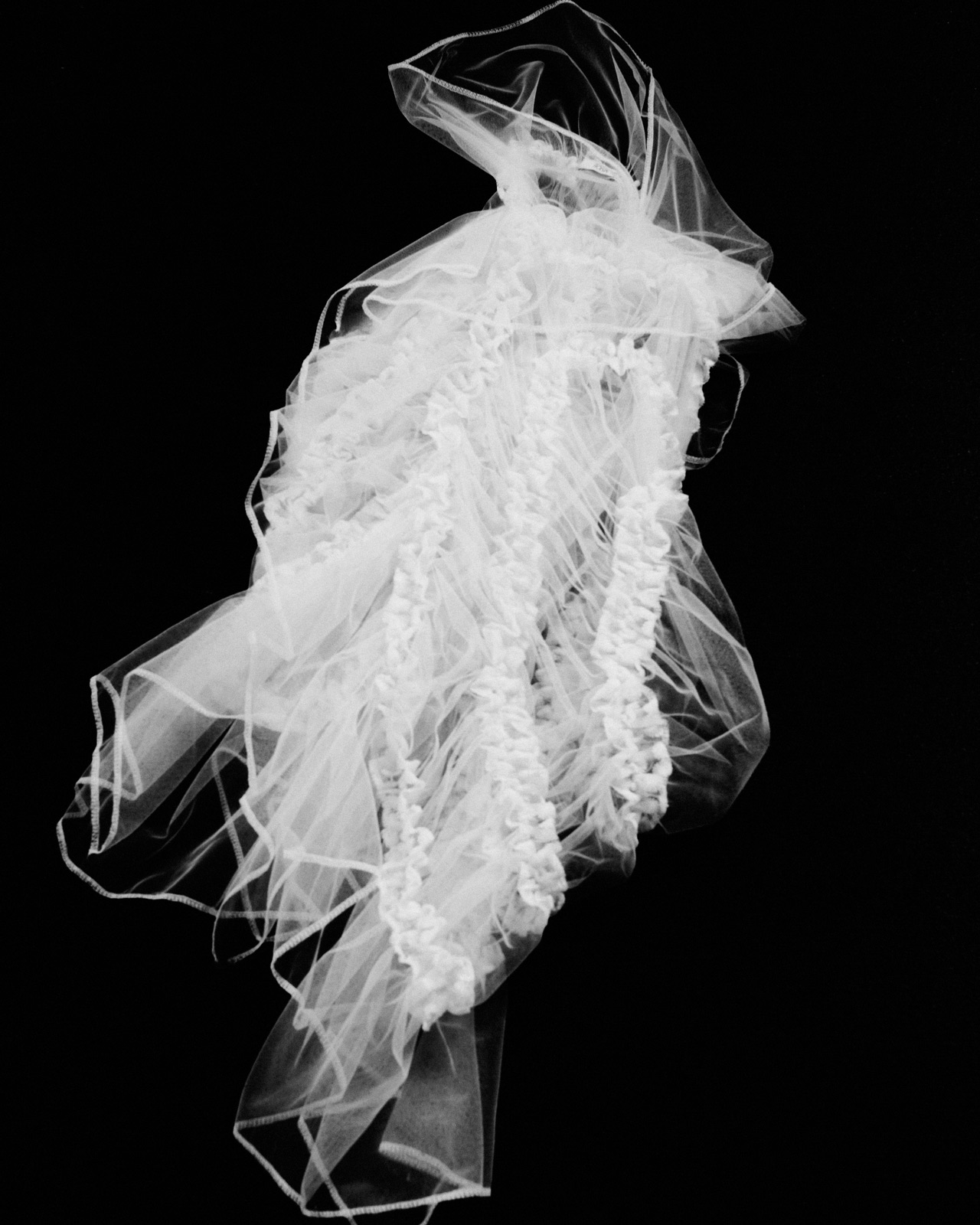The designer speaks with Document on her unique philosophy, shunning the moodboard, and finding resilience in softness
Making something new out of a craft that’s very old is no minor undertaking. But it’s what Róisín Pierce has set out to do at the helm of her eponymous label, launched in 2019. The craft in question is Irish lace—“a symbol of hope,” in the words of the budding designer. “It helped my nation out of the tragedy of the Irish famine—a vital way for women to support their families and bond, creating communities.”
Pierce doesn’t seek to “reiterate” tradition, but to revive its cycle of life. Her garments leverage the language of lace—white panels, embroidered with often-floral motifs—to create forms never before seen. Last season, she showed a collection in the American Church in Paris, channeling iconoclasm and the drama of religious ceremony in one breath. The gowns grew more detailed as models marched forth, ruched and cut-out and meticulously decorated.
Pierce works in tandem with history; her practice isn’t so much concerned with producing as it is with furthering a highly personal mission. “My brand looks to preserve traditional artisanal techniques by incorporating them into my vision of unconventional yet beautiful clothes,” she says. “By investing in craft, these skills will live on.”
Here, the designer speaks with Document on her unique philosophy, shunning the moodboard, and finding resilience in softness.
Morgan Becker: Tell me about your earliest exposure to fashion.
Róisín Pierce: I was surrounded by creation from an early age. My mother sewed and knitted outfits for me and my siblings, and she made a painting studio in the attic of our home in Galway that I would often retreat to. I liked how feelings, thoughts, and energy could [generate] something much larger than myself—new dream worlds created through beauty and craft.
From there, I started playing with surfaces and sculpture. What I created as a child wasn’t necessarily wearable, but I did have a strong interest in materials. I thought it was amazing—the differences [that] small changes [in] cut, thread, and needle could make. I have been consumed [with] new creation for what feels like a very long time now.
“I’m interested in creating beauty for women, to experience life through a new lens of liberation. Each flower, each motif, each symbol has a meaning.”
Morgan: How have your design philosophies evolved, from then to now?
Róisín: The design philosophy hasn’t changed. Design is an emotion that moves me, weaving in personal experience, memories, and nostalgia. There is a zone I tap into to create, where everything just flows—that is my happiest time. At the brand, we work through the unknown, allowing sampling, material exploration, and emotion to dictate the final pieces. It’s a very intuitive and organic process.
Since our first collection, released in April 2019, we have undertaken a deep exploration into Ireland’s relationship with faith, ritual, and tradition, referencing the notion that women are perceived as flowers—beautiful, living things, existing simply to be looked at. I’m interested in creating beauty for women, to experience life through a new lens of liberation. Each flower, each motif, each symbol has a meaning. I embrace the power of the feminine through a combination of artisanal work, embroidery, lace, and smocking to form clothing that has not been created before. Within each piece is the ability to find power and resilience in softness and beauty.
I’m also interested in forgotten crafts which deserve to be regenerated. My aim has not been strictly to reiterate traditions, but to renew and revive. I start from scratch with brand new textiles and techniques, which is something I’m quite proud of, because it’s not that common.
Morgan: How did your work with lace first originate?
Róisín: I’ve always had an affinity for lace; I grew up with crocheted lace cardigans, lovingly made for me by my mother. As a teenager, I attended summer classes hosted by the Irish Lace Guild and learned traditional lace-making with my mother. In secondary school, I produced an all-white lace collection of large-scale airy mohair pieces, made with a giant broom hook I created, challenging the traditional craft. As I continue to work with Irish lace, I see it as a symbol of hope. It helped my nation out of the tragedy of the Irish famine—a vital way for women to support their families and bond, creating communities of craft.
Morgan: What does that exclusively white palette signify?
Róisín: White means many things to me; I’m inspired by the purity and beauty associated with the shade, and I find it to be a poetic and beautiful color. It has links to death, life, rebirth; it references so much. It started as a way of working with the notion of marriage and ceremonial dress, allowing me to explore fabrics typically used in bridalwear, like organza and tulle. I was inspired by the bridal gowns of the Magdalene Laundries, [made by] women dubbed ‘unwed mothers.’ It was also an ode to ‘white work’ handcraft—crocheted Irish embroideries made exclusively in white.
Working in white is a challenge. You need to have good construction, a meticulous approach, and lots of ideas. But I now find the color aids me in my search to create the new. It requires me to continually challenge my practice, to create new forms: sheer panels, cloistered embroidery, patchworked organza.
Morgan: Sustainability is a core tenet of your practice. How does that impact your creative process, from ideation to the actual construction of a garment?
Róisín: We work with some recycled and deadstock materials, as well as an eco fabric made from wood pulp. In addition, about 90 percent of the collection is created using a no-waste approach, and it allows for a more creative exploration of textiles. We use strips and squares of fabric, avoiding offcut waste—to create something that sits beautifully on the body is a challenge. When we combine these unforgiving shapes with our signature smocking, they become soft—no longer squares and strips but ribbons, bows, and roundels.
Morgan: Much of your work is produced locally. How collaborative is that physical process?
Róisín: My pieces are extremely complex, and created using a unique, artisanal approach. This requires textile specialists. The majority of the pieces are created in-house, by myself and specialists who are chosen according to their skills. There is also an investment in the future of crafts and the preservation of intergenerational knowledge. For instance, my mother has lent her skilled hand, and for my fourth collection, Beware, Beware, three generations of lacemakers came together in my studio to collaborate—the experienced practitioners guiding and teaching the younger makers in the group.
“I don’t shy away from the highly ornate or the feminine. I embrace it. And in this space, I can honor forgotten women and forgotten crafts.”
Morgan: What have you learned from it?
Róisín: Creating in this way is not an easy feat. Artistry and construction are so central to my brand—maintaining the quality and conscience that underpins them is imperative. There is a core dedication to, and understanding of, craft’s wider cultural impact. My brand looks to preserve traditional artisanal techniques by incorporating them into my vision of unconventional yet beautiful clothes. By investing in craft, these skills will live on.
Morgan: Where do you seek out visual references—even outside of the realm of fashion?
Róisín: I’m moved by emotions, and that drives the work to unexplored places. I think nature is astonishing because it doesn’t set out to be beautiful—it just is. Its purpose is not to give us joy, and yet it does. I don’t shy away from the highly ornate or the feminine. I embrace it. And in this space, I can honor forgotten women and forgotten crafts.
There is no moodboarding in my design process. The process itself dictates the final outcome, organically developed through sampling and creative exploration. I work to disrupt accepted design methods.
Morgan: How do you hope your audience will feel, in witnessing or wearing one of your designs?
Róisín: Excitement, intrigue, and beauty. I think the best reaction to my clothes is that the wearer feels something. Some feel a close connection to the pieces, and it’s quite strange to witness how drawn people are to them—how people are sent to a dream-like world, and are excited for others to see them. That is quite special.











